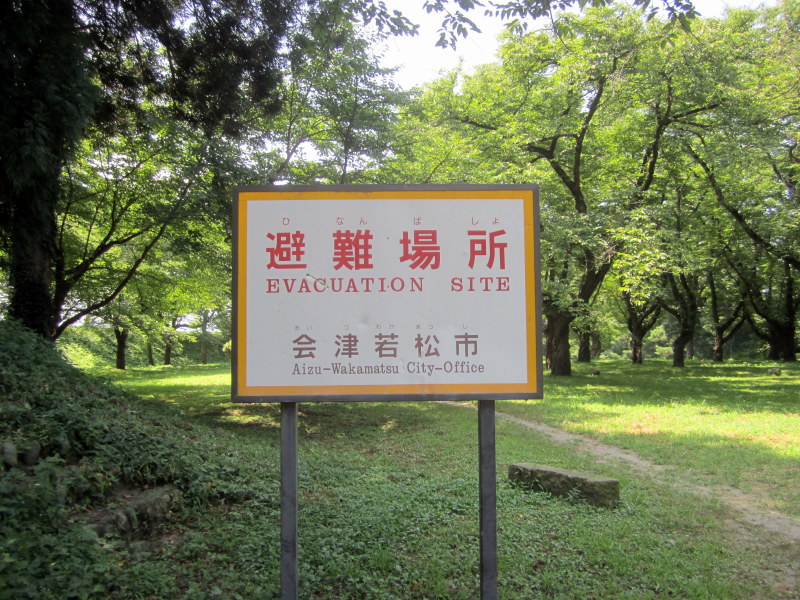A Year Later – The Japan Disasters and the Surviving Cats: Part 1 – Introduction
There are certain events in life that cause one to pause and reflect where they were at that moment. I remember for me, March 11, 2011, the date of the Tohoku earthquake and tsunami in Japan and the resulting Fukushima nuclear meltdown, that it was a Friday and I was already at work before I realized what was going on around me. The chain of events began unbeknownst to me at 12:45 am, EST, which translated to Friday, 2:26 pm in Japan. I originally found out from Dan via a text message that there was an earthquake – we did not have a television in my office and the enormity of the situation did not hit me until I got home and saw the news footage replaying the same devastating scenes over and over.

At first glance, this image looks like a jigsaw puzzle of matchsticks strewn haphazardly on the floor. In reality, this is an aerial view of the resulting debris from the earthquake and tsunami that struck northern Japan on March 11, 2011.
For the hundreds of thousands of people along the northern coast of Japan, first came the roar and rumble of the 8.9 magnitude earthquake that had skyscrapers swaying in the wind and buckled highways, followed by gigantic waves as high as 30 feet that rushed ashore, whisking away cars and carrying buildings set ablaze by fires towards factories, fields and highways.
Thousands of homes and businesses were instantly destroyed, numerous roads were impassable, public transportation was not running, and power and cellphones were down. The tsunami caused a number of nuclear accidents, most significantly, the Fukushima Daiichi Nuclear Power Plant meltdown that resulted in an evacuation for nearby residents from 20-30km around the plant (13-19 miles), with up to 20km being mandatory and up to 30km, highly advisable.

Streets became impassable as they were ruthlessly littered with collapsed homes, businesses, and large boats that became land bound as if they were a child’s toy. File: US Navy 110315-N-2653B-148, CC BY 2.0
As I watched the events unveil, it all seemed so surreal to me and the full scope of it did not sink in. I was in shock, I was horrified, my heart broke for the people, the graphic pictures moved me, I wept, I grieved, I donated money, but it was just so far away and I will admit I was not immediately connecting the dots insofar as how it affected the overall pet population, in particular, cats.

No picture better expresses the futility and hopelessness for the thousands of pets that lost their lives as a result of the disasters than this surreal image of a house serenely bobbing in the water as if it were meant to be. So many animals were left inside homes by pet owners who thought they would back later to attend to them.
Assuming that they would be back in a few days, most pet owners left their cats and dogs either indoors or tied up when the tsunami warning sounded, never imagining just how large and powerful that wave would actually be and the great majority of these animals did not survive. Those that did were left to fend for themselves, in a hostile and dangerous environment with no food source or fresh water. Many of the owners of these surviving pets were killed, or living in evacuation centers that did not allow pets, leaving these displaced animals desperately struggling to survive. There were also thousands more that were left behind when evacuation orders were enforced because of the Fukushima meltdown and owners were not allowed back due to radiation fears.
A full year later, with my newfound status as an author and cat blogger, I can truthfully say that it all seems very real now and I realize that despite the miles and difference in cultures, we really are but a connected universe of one people who want to make a difference. For Jennifer Koca, that difference was cats, and for us, complete strangers who met via my blog and facebook, that was our connection and I have come full circle – the dots have connected and through a series of email conversations, Jennifer and I agreed that it was important the story of the Tohoku/Fukushima cats in the aftermath of the disaster be shared as much as possible.
Today I will briefly introduce you to Jennifer – why she came to Japan and what she experienced when she first arrived. As the days progress, I will then introduce you to several other incredible people who have given their lives to helping these cats, what the daily obstacles are that they face, and what we can do to help. And please bear in mind, this was not the easiest task for me to undertake – the enormity of the situation is daunting and I had to remain fair – the purpose of these posts is not to judge a culture, but to help educate people about the Tohuko/Fukushima situation with respect and dignity. Public misconception about cats is a universal problem, and Japan is no exception…

Jen in the states with some of her feline friends – L to R – Brownie, Trouble, and Angel. Brownie and Angel are Jen’s cats and Trouble has since been adopted!
Jennifer was living her comfortable life in Herndon, VA, as a 1st grade special education teacher along with her boyfriend, her friends, family, and her two beloved cats. She and her boyfriend were both big into animal rescue, with Jennifer being a near full-time volunteer with the Richmond VA SPCA. About a month before the disasters struck, they had been offered jobs in Japan as Assistant Language Teachers (ALTs), but as soon as they heard about the situation in Japan, they wanted to leave immediately to help these poor cats that were barely clinging to life amidst the wreckage.
Unfortunately, it was not as simple as just packing up and leaving the next day and all she could do was was talk to the people in Tohoku and it was killing her that she could not be there to help in person. Visas take a long time to get and she also had commitments to her state-side job. Once the visas were in place (two weeks later) she quit her job and was on her way to Tokyo with her boyfriend for training. They moved to Yamanashi prefecture as ALT’s and this particular area was not hit hard by the disaster. On long weekends or school breaks, they volunteer with the Japan Cat Network (JCN) and the 5 hour trip (one way) costs $250.00 in tolls. I was incredibly curious and my first question to her was, “What did the Fukushima surroundings look like the first time you met with the JCN staff?”
Jennifer indicated that different areas of Fukushima were in different states of distress after the disasters. The areas very close to the coast where the tsunami hit were littered with giant boats, there were huge cracks in many buildings, and there were paper cranes everywhere (the Japanese symbol for peace). The places that were simply evacuated, felt like time had stopped entirely. She said it was incredibly eerie to drive through a town and not see or hear any signs of human life.

This picture came from the students of Jaffrey-Rindge School District in New Hampshire – one of many schools and organizations that folded origami paper cranes to send to Japan to help fundraising efforts. For each of the 1,429 cranes that they folded and sent, two dollars was donated from the Bezos Family Foundation to Architecture for Humanity’s reconstruction efforts. The cranes are symbolic in Japan of peace and hope, and, according to legend, anyone who folds 1,000 of them will be granted a wish by a crane.
Cats lined up along the road, searching for food or their owners, dogs ran to you, whimpering, as if they were wondering if you could tell them where their family had gone. And then there were the unlucky ones – every trip she took into the evacuated areas forced her to see at least one dead body. Usually they looked like they had died from starvation and all of them looked like they had suffered terribly.

This starving and malnourished cat typified any number of cats wandering the streets after the disasters. Luckily this cat has since found a happy ending and has been adopted into a forever home…
She said that most people that were made homeless moved into shelters, most of which were old gymnasiums or warehouses where they were allotted a small area to call “home.” Pets were not allowed inside these makeshift places, so many people had to leave their animals in cars, or simply release them into the streets. All shelters had far too many people and there were long winding lines for people just waiting to get a drink of water. A year later, some people are still in these shelters, their lives stuck in limbo.

This cat peers out from the woods and is part of the aftermath of the disasters – was she a pet, stray, or feral? Because of the traumatic experience, it is very difficult for JCN volunteers to distinguish what they are dealing with and that is one of the biggest obstacles they face.
I now put myself into this mindset and it physically pains me to think of what my life would be like if I had to make a conscious decision to release any of my beloved cats into the street. In the next post of this series, we will look closer at this – what the perception in Japan is of pet cats, feral cats, stray cats, and shelter cats and why the fine line between all of these types of cats on the streets is so grey in light of the disasters.
This series of posts was in the works prior to the devastating tornadoes that hit the Ohio Valley and several Southern States last week. We offer our sincere prayers to everyone whose lives have been affected. Many animals will need help during the recovery period and we ask that you check with sites such as Petfinders.com for ways to offer assistance and to donate towards the cause.
As far as helping the cats in Japan, I will be discussing that in length in upcoming interviews. In the meantime, please go to this link at Japan Cat Network for ways that you can contribute and help.

























Deb, thank-you for this thoughtful post. Did you see Must Love Cat’s show about Japan last night? What struck me was the odd juxtaposition of the Japanese obsession with cats like maneki neko, cat cafes, and shrines on one level and yet most apartments don’t allow pets, most cats are not micro-chipped and lots of cats were abandoned in the evacuated zone after the tsunami.
You are welcome Layla, and yes, I did see the show. There is an enormous discrepancy as to how Japan perceives cats as you will see in my posts to come. That was probably the most difficult part of writing this series – I had to step outside of the situation and respect a culture that has a serious need for education regarding shelters, strays, ferals, and TNR. While the show last night was good, it very much glossed over the truth of much of the situation in the disaster area. There is also a significant difference in perception between upscale urban Japan, versus traditional and conservative rural Japan.
I’m glad you decided to feature this topic, too, Deb, and as always, you covered it with your signature sensitivity. I’m looking forward to your next piece in this series!
Thank you Ingrid – your post was wonderful as well and it really is an important subject.
The Woman cannot imagine a situation where she would ever leave us out to fend for ourselves. I think she would live in her car or on the street with us, first. What a horrible decision these people had to make.
Chey – I pray we never have to be faced with such a heartbreaking situation in our lives. It truly teaches us to treasure what we have and live with kindness and charity. I don’t think I could have left my cats either and probably would have perished with them if I had to make the choice…
Some people actually did end up living in their cars instead of the shelters to keep their pets company, many of those people thankfully heard about groups like us (JCN) before too long into the ordeal.
Oh, this makes us so, so sad. We can’t even begin to imagine…
It is very sad meowmeowmans, but we do have to talk about it to help make it better. In so many ways, this was one of the most difficult undertakings I have ever dealt with. But, it also gives me hope. There are so many wonderful people in this world who devote their lives to helping others, whether it be animals, people, or both. I am honored to give a voice to this story and hope that ultimately one day every cat will have a home, or if it does live in the streets, be properly spayed or neutered and allowed to live with respect and dignity within its community.
Like Layla, I too wonder at the seeming contradiction between the almost reverencial treatment of cats on one hand and the ignorance of the reality of their needs etc on the other!
A good, thoughtful post, Deb. I can’t imagine any situation when I would knowingly leave my cat to fend for himself. It would break my heart! xox
Carolyn –
The issue is far more complex than it appears on the surface, and that is why I will be telling the story in a series style. As I said to Layla, much of it is cultural issues, much of it is how the disaster itself was managed by the government, and a lot of it was the simple fact that these people actually thought they would be back to attend to their pets in a matter of hours and had no clue as to how severe the situation would turn out to be. Mixed into all of that is a nation that has very few animal shelters as it is and a high ratio of homeless stray and feral cats – so, it becomes very, very complicated.
to everyone, here is a video you should see, it is a pet owner from Fukushima begging for help for all the animals left behind. She and many like her did not want to leave their pets behind, they were forced to.
Many people in Japan do not treat their animals very kindly, this is true, but there are many others who see them as their family members.
http://www.youtube.com/watch?v=0frBRQ_ndls
There are also many videos of people returning to visit their dead livestock to pray for forgiveness for not being able to save them.
And to Deb, thanks once again for caring enough about the animals to call attention to this ongoing tragedy
Jen – that is why I felt it was so important to tell the story of the aftermath of the disasters as a series. This is such a complicated situation that cannot be told in a few sentences. There is no doubt that many of the Japanese people love their pets dearly and the anguish and hopelessness of the situation must have been unbearable. Much of the problem was due to the fact that disaster preparedness did not effectively take the pets into account and most did not realize how severe the aftermath would be. Factor in the overwhelming fear of radiation and having no home any longer to go back to and it becomes very complicated. Thank goodness for places like JCN to help these people and animals out.
I thank you again for giving me the opportunity to interview you and the others Jen – you have helped to bring a new level of attention to this situation that needs public awareness.
We so remember watching the horror on the television, it still makes my heart hurt.
Yes Brian, that is a good way of putting it – it makes my hurt as well for those that lost lives and for those that are trying to rebuild new ones.